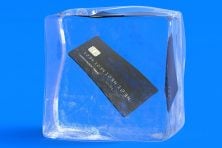Here’s How to Easily Wipe Out Old Debt and Improve Your Credit Score

We get it: Paying off your debt and improving your credit score isn’t the easiest thing to do.
But the truth is, many of us make it out to be a lot more intimidating and complicated than it has to be. The key? Break the process down into steps, and conquer them one by one. This will look a little different for everyone, but here’s what we suggest starting with:
1. Choose Your Debt Payoff Method
Before you do anything, you’ll want to figure out which debts you want to prioritize paying off. Many financial experts suggest one of two methods:
- The debt avalanche method: This method of paying off debt requires you to prioritize the debt that has the highest interest rate first. For example, if you owe $20,000 on a student loan that has a 5.2% interest rate and $8,000 on a credit card with an 18% interest rate, start by paying down the credit card first. The idea is to save money on interest over time.
- The debt snowball method: With this method, you pay off the smallest balances first. Sure, your cards with higher interest rates will linger, but if you’re the type of person who craves immediate gratification, this will give you the motivation you need to become totally debt free.
Now that you know which debts you want to pay off first, it’ll be easier to build a budget around these monthly payments.
2. See What Else You Can Do to Improve Your Credit Score
Created a debt-payoff plan? Check. Making on-time monthly payments? Check.
Now that you’re chipping away at your debt, it’s time to peep your credit score. For many of us with debt, it’s something we’d rather not see. But trust us: The sooner you start improving it, the better.
First thing’s first, ya gotta look. We like using a free website called Credit Sesame. Not only can you see your credit score, you can also see what factors are affecting it and get tips on how to improve it.
Now, we need to warn you: You might get a little addicted to checking your credit score, especially because you’ll probably see it start to increase as you pay off your debt. Some people have said it becomes a bit of a game — you competing with yourself to see how high you can get it.
That’s what happened to 50-year-old James Cooper of Atlanta. Over the course of six months, he watched his credit score increase almost 300 points as he paid off nearly $6,000 worth of unpaid bills and took Credit Sesame’s recommendations.*
“They showed me the ins and outs — how to dot the I’s and cross the T’s,” Cooper says. He now uses the lessons he’s learned from Credit Sesame to teach high school students the importance of good credit.
Want to take a look for yourself? It takes just 90 seconds to get started.
3. Find Extra Money to Put Toward Your Debt
Some of us might land in this situation: You have a plan and you want to pay down your debt, you really do, but you just can’t afford it. You’re living paycheck-to-paycheck as it is.
In this case, you have two choices. You can choose one or both:
- Cut your monthly expenses: You might think “it is what it is” when it comes to your monthly bills, but there are ways to save money. For example, call up your cell phone provider and negotiate. If that doesn’t work, look into discount carrier options. For your car insurance, shop around — rates are constantly changing. Use this bill-cutting guide conquer the rest.
- Increase your income: We know. The thought of getting a second job probably makes you want to puke. But luckily there are plenty of flexible side gigs you can do in you free time. Look into delivering groceries with Shipt or walking dogs with Rover. And know you won’t have to do this forever — just until you can get back on track.
Whatever money you’re able to save on your bills or earn with a side gig can go directly toward your debt!
*Like Cooper, 60% of Credit Sesame members see an increase in their credit score; 50% see at least a 10-point increase, and 20% see at least a 50-point increase after 180 days.
Credit Sesame does not guarantee any of these results, and some may even see a decrease in their credit score. Any score improvement is the result of many factors, including paying bills on time, keeping credit balances low, avoiding unnecessary inquiries, appropriate financial planning and developing better credit habits.
Carson Kohler ([email protected]) is a staff writer at The Penny Hoarder.


















